August 2018 – We absolutely love our 2016 Dodge Ram 3500 Dually truck, and we recently installed an Amp’d Throttle Booster on it. This small electronic unit decreases the occasional throttle lag you feel when you depress the accelerator pedal by increasing the throttle sensitivity and responsiveness.

Amp’d Throttle Booster Installation and Review
On older vehicles the accelerator was connected to the carburetor with a cable, providing a physical connection between the action of your foot depressing the accelerator and fuel flowing to the engine to make the vehicle go faster. On newer vehicles electronic signals do the job instead, and occasionally there is a slight lag between depressing the accelerator and fuel flowing to the engine. This is sometimes referred to as a “dead pedal” kind of sensation, and it can be a little frustrating to hit the gas and not have the vehicle jump in response right away.
The Amp’d Throttle Booster allows you to increase the throttle sensitivity by slightly raising the voltage. There are three sensitivity settings along with a Stock setting that doesn’t increase the voltage at all.
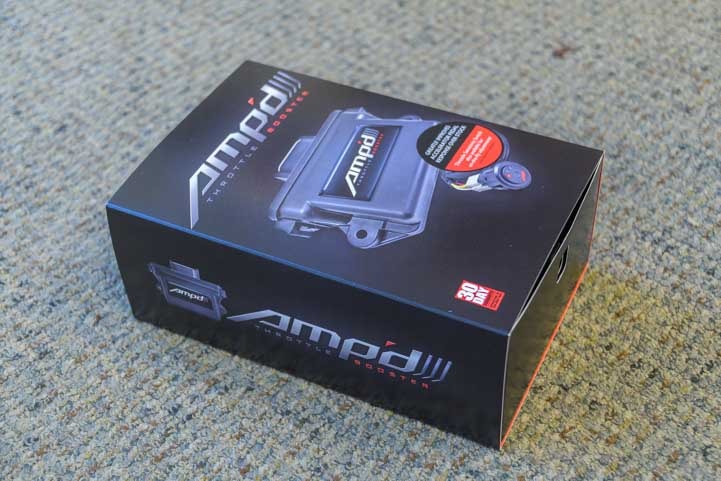
Edge Amp’d Throttle Booster
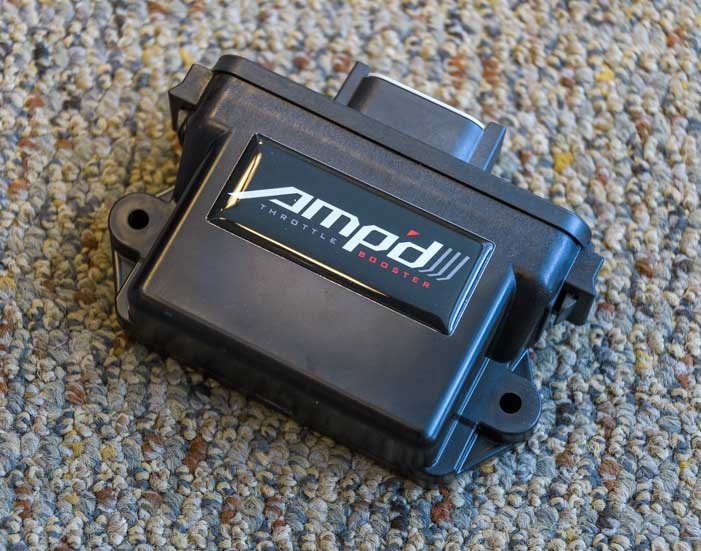
The Amp’d Throttle Booster core unit
The Amp’d Throttle Booster is a small product that comes in two parts: the booster unit itself and a wiring harness.
The harness assembly has three ends:
- One end that connects to a selector switch that gets mounted on the dashboard (labeled “A” in the photo).
- One end that connects to the booster (“B”).
- One end that has a Y connection that connects to two points under the dashboard (“C”).
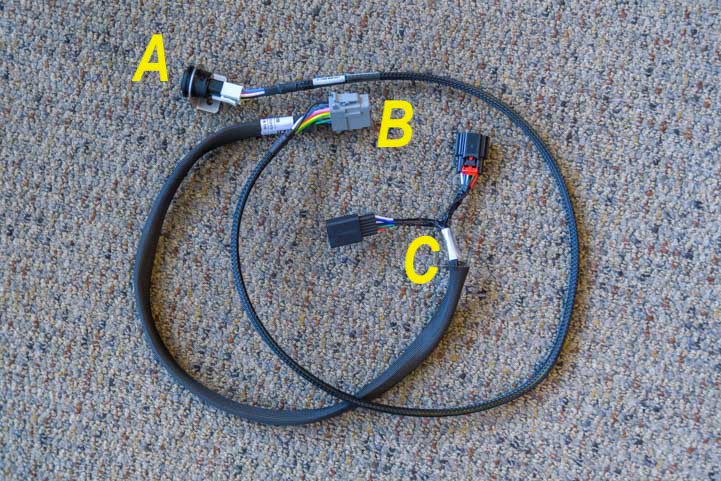
The wiring harness has three ends.
A = Dashboard mounted selector switch
B = Connects to the Amp’d Throttle Booster unit
C = Both connectors connect under the dashboard.
The installation took 17 minutes, but allow a little bit more for reading the manual, etc!
The first step was to connect the pair of connectors at the Y end of the wiring harness to the corresponding connectors under the dashboard. These two connectors are keyed, so you can’t connect them backwards or accidentally plug them into the wrong spots.
Working under the dashboard was a tight fit, so I have a link to the Amp’d Throttle Booster manual at the end of this article to give you the nitty gritty about each connector and where it is positioned under the dashboard both for the Ram trucks and for other brands and model years.

First connect one of the two ends of the Y on the wiring harness to the corresponding connector under the dashboard.
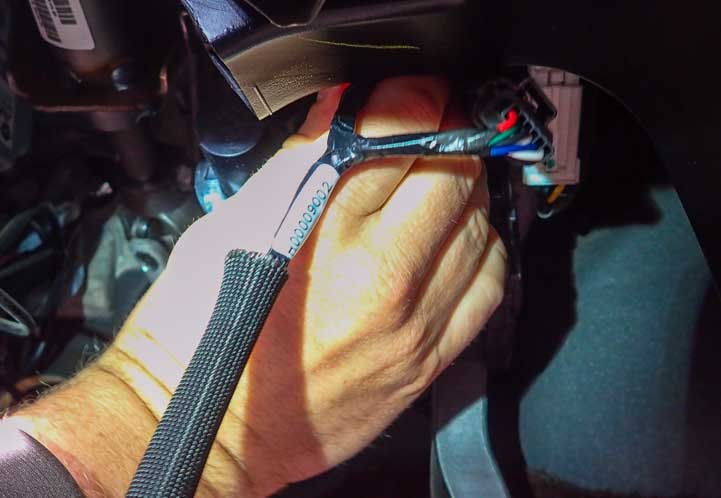
Connect the second of the two connectors at the Y end of the wiring harness under the dashboard.
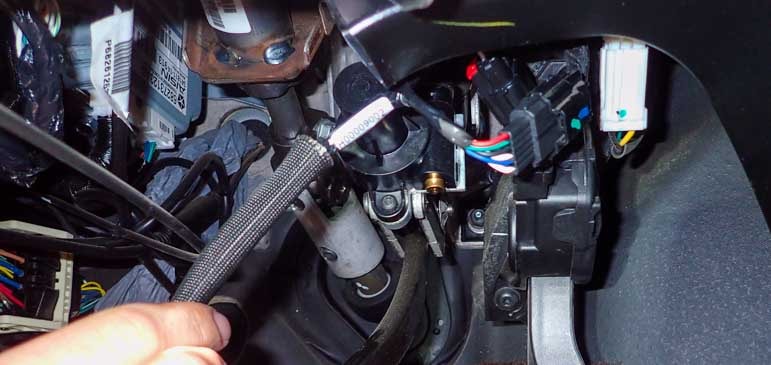
Both connectors are in place (only one is visible).
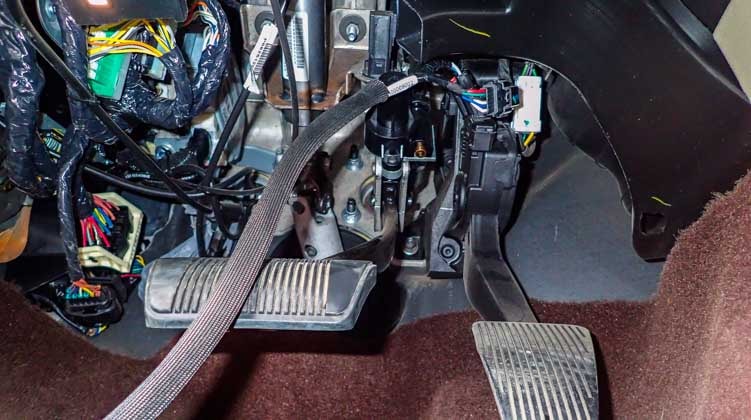
It’s tight under there but the connectors are keyed to make it easier.
We got the kit that includes the dashboard mounted selector switch. If you don’t buy this external switch there is a switch right on the circuit board inside the Amp’d Throttle Booster unit that has two sensitivity settings, Low and High.
Regardless of whether you get the dashboard mounted selector switch or rely on the circuit board switch instead, the next step is to set up the Amp’d Throttle Booster so it can learn the throttle response of your truck’s accelerator.
To begin this learning sequence (and to access the circuit board’s selector switch), simply unscrew the outer casing.

Access the Amp’d Throttle Booster circuit board and go through the Learn sequence by removing the outer casing.

The red arrow shows the location of the circuit board selector switch. It is set to Stock (Off).
Then attach the wiring assembly to the connector on the Amp’d Throttle Booster unit and follow the sequence of steps given in the manual to enable the throttle booster to learn the throttle response of the truck’s accelerator (this involves depressing the accelerator pedal a few times and monitoring some LED flashing lights on the circuit board).

Plug the wiring harness into the connector on the Amp’d Throttle Booster unit.
Then mount the selector switch on the dashboard. One handy location is on the plastic tab at the bottom of the dashboard that holds the dashboard in place. Simply remove the existing screw, position the mounting bracket and screw it back in.
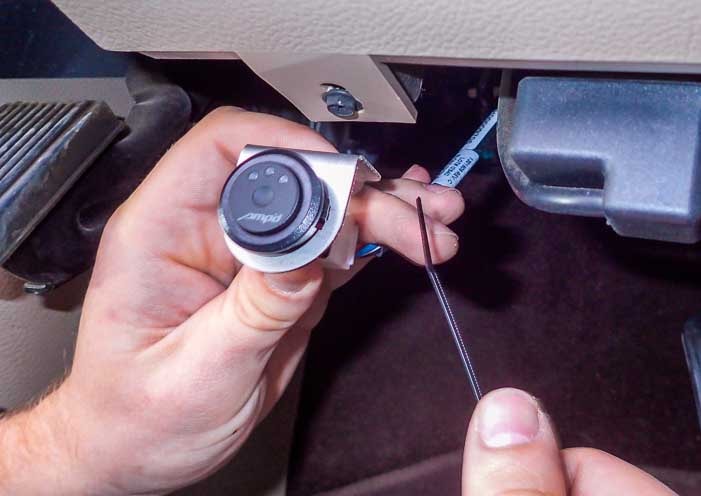
Mount the selector switch on the dashboard and tidy up the wiring harness with tie wraps before tucking it under the dashboard.
Once it’s mounted, tuck the harness assembly and the Amp’d Throttle Booster unit up under the dashboard and secure them in place with zip-ties.
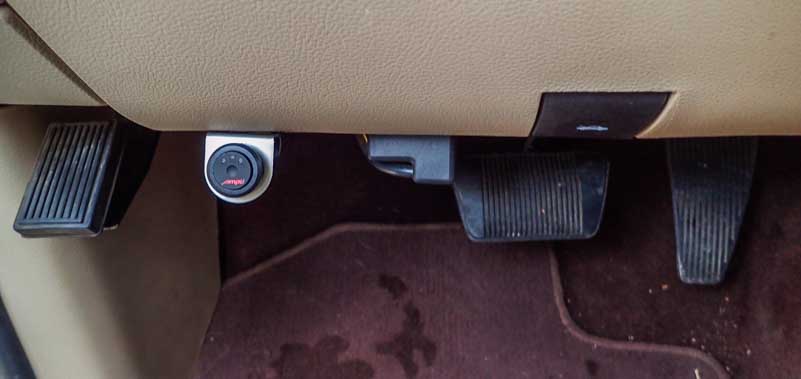
Finished. The selector switch is easy for the driver to reach.
After the installation of the Amp’d Throttle Booster, Mark tested it with the truck in Park. He put the selector switch to Stock (Off) and revved the engine. The he did the same thing at each of the three settings: Low (50% sensitivity increase), Medium (75% increase) and High (100% increase). At each increased setting the engine responded faster to his foot depressing the accelerator pedal — as expected.
Mark has been driving with the Amp’d Throttle Booster installed on the truck for the last 5,000 miles, and he’s found he likes it best at the High setting (100% increase) which is where he keeps it set all the time.
He finds he notices the improvement a lot when passing people and also when driving in the mountains as well as when he’s in stop-and-go traffic.
Without the booster he sometimes finds that on a steep incline or when “gassing it” for whatever reason, he’ll depress the accelerator and then have a moment or two of no response from the engine before it kicks in. With the booster on High, the truck reacts and accelerates much more quickly.
We also have an Edge Juice with Attitude engine tuner on the truck, and Mark finds that the two work together well. He puts the engine tuner in Level 2 (Towing) and leaves it there most of the time. This improves the engine’s power when it’s towing our trailer.
Whenever we’re going to be driving the truck without the trailer attached for a long drive or for a few days of in-town driving, then he puts the tuner in Level 1 (Economy). This improves the fuel economy significantly.
Our truck has about 35,000 miles on it now, and we’ve owned it for two and a half years . For anyone wondering how many miles they might drive in the full-time RV lifestyle, there you have it — we’ve averaged 14,000 miles a year since January 2016, about half of that towing our trailer and half of that driving without our trailer hitched up.

Subscribe
Never miss a post — it’s free!
More info about the Amp’d Throttle Booster:
- At Amazon: The Amp’d Throttle Booster for Ram, Ford & Chevy diesel trucks
- Product Info by Vehicle Make/Model
- Amp’d Throttle Booster Manual
Other blog posts related to trucks and towing:
- B&W Companion Hitch Performance in a Fifth Wheel Trailer Rollover Accident
- B&W Companion OEM Fifth Wheel Hitch Installation – Easy!
- Basic RV Tool Kit – Essential Tools & Supplies for Rvers
- Demco 21K Recon Fifth Wheel Hitch Review and Installation
- Dodge Ram 3500 Dually Truck – Best RV Fifth Wheel Trailer Towing
- Edge Engine Tuner => Max Truck Power!! (Escapees Mag Feature!)
- Edge Evolution CS Tuner Review – Peak Truck Performance!
- How To Change The Inner Rear Tire on a Dually Truck
- How to Fix a Car or Truck Key Fob in Minutes!
- How to Put DEF (Diesel Exhaust Fluid) in a Truck & Which is Cheapest?
- One Ton Towing Machines and 75 Years of Trailer Life
- Out with the Ram Diesel truck and In with a…??
- Reese Goose Box Review: 20K Gen 3 TESTED + How to Hitch
- RV Mountain Driving: How to drive your RV safely on mountain roads
Our most recent posts:
- How to Install Starlink Gen 3 in an RV? Use the Speedmount! 08/07/25
- Escape to Paradise – Rocky Mountain Magic! 08/01/25
- Is Forest River a Good RV? Well Built? Here’s Our Experience 06/20/25
- Sunset Crater Nat’l Monument – Lava & Camels at Bonito CG! 06/06/25
- 2024 Alpha Wolf 17CB Trailer – Our Goldilocks RV! 04/25/25
More of our Latest Posts are in the MENU.
New to this site?
Visit RVers Start Here to find where we keep all the good stuff. Also check out our COOL NEW GEAR STORE!! *** CLICK HERE *** to see it!

Hi ya’ll,
Its always great to read your posts. While a great vehicle, the dodge cummins truck is having problems with the DEF system, as are some other brands. My buddy twice got the message on his screen “you have 75 miles to fix this or your speed will be reduced to 15mph”
He got to a dealer and luckily parts were available cause this situation is common and sometime parts cannot be built and shipped fast enough.
He has since got a kit and stripped the DEF system out of the vehicle. In his mind, the only permanent solution.
Other than that, its a great vehicle, in my opinion passing the Chevys and Fords. The engine is the best, i have one in my boat!
We’ve been driving Dodge Rams since we started full-timing 11 years ago, and we love these trucks, although there was a world of difference between the 2007 single rear wheel 3500 (our first truck) and the 2016 dually 3500 (our current truck) — the latter can tow almost twice the weight of the former!! We haven’t heard of a problem with the DEF. Mark tops it off when it gets down to about half full. He’s wondering if that error message was due to a clogged particulate trap and not the DEF. There are complex algorithms in the truck for choosing when and where to burn off the particulates, and we’ve found the newer truck handles it better than the old truck (i.e., it’s less likely to choose to do it when we’re on a 10% grade in the Rockies!). Can’t beat the Cummins engines. Nice you have one on your boat.
You guys are lucky to have all this tech experience, and knowledge and the guts to try it out!
Very interesting article, Mark and Emily.
Without Mark’s know-how none of this would happen. I love learning from him so I can write about it, and I’m grateful for my own tech background, but it’s his years of working on cars growing up that makes all of this possible, including the boating. Many sailors are intimidated by their boat’s engine (one editor for Cruising World Magazine said she and her hubby nicknamed theirs, “Mr. Engine, Sir!”) but when Mark saw the scary big 54 hp diesel in ours his reaction was, “Oh, that’s so cute!”
Curious, has it affected your mileage at all?
No.
LOVE, LOVE, LOVE your “tech” writing, Em – and the kudos you give Mark – as “chief engineer” !!!!
Mark is definitely the Chief Engineer in this household and Buddy is the Foreman. I just stick to my keyboard and write!!